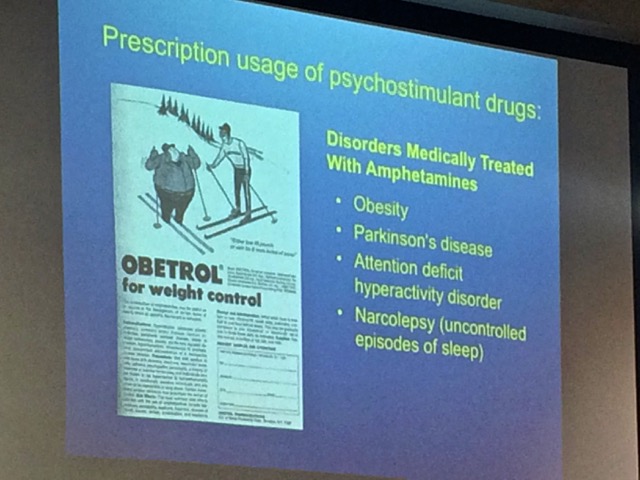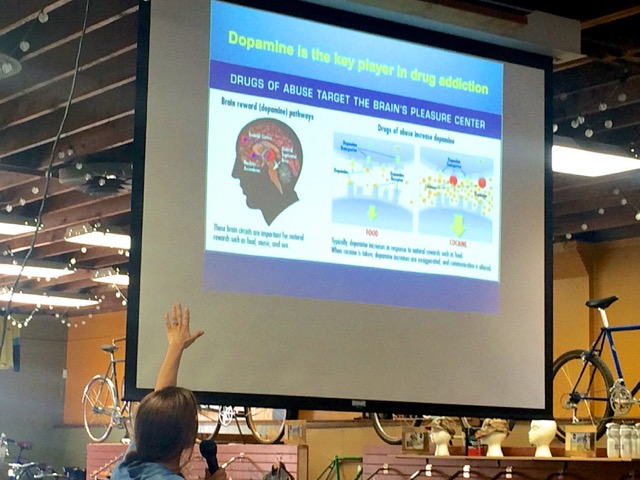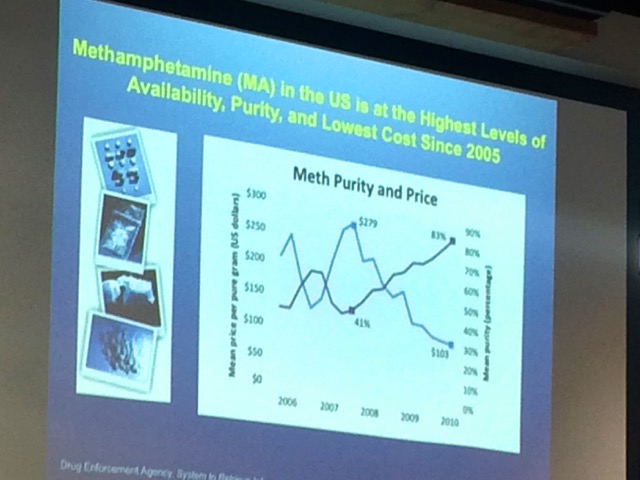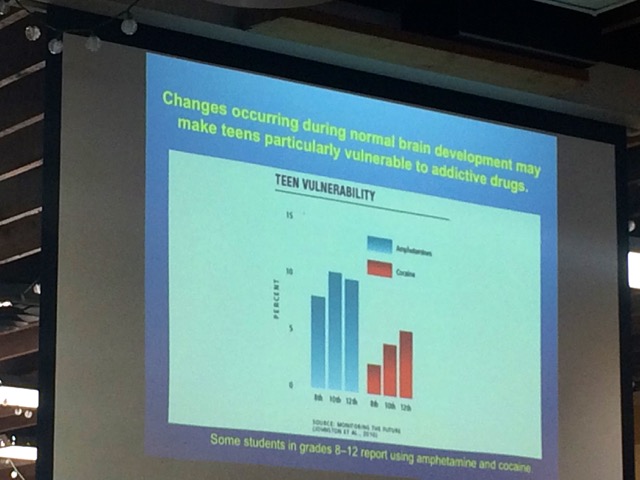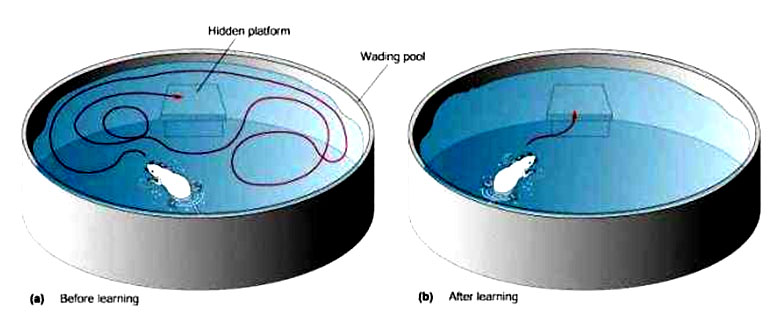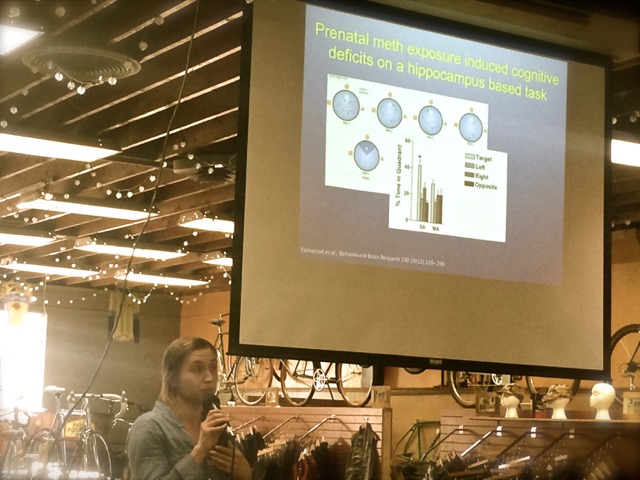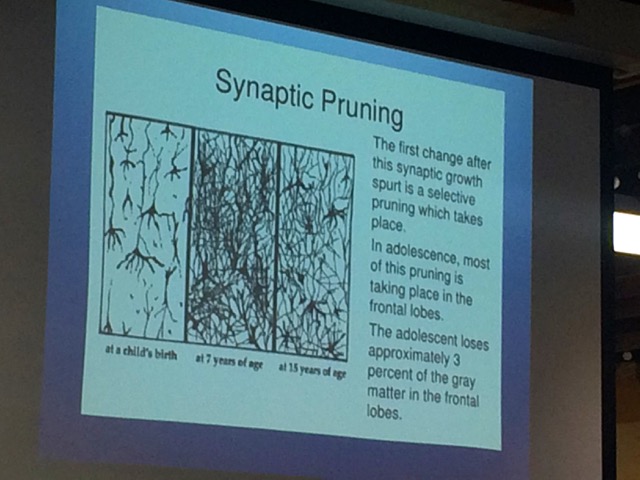We celebrated our first year of free art and science events at Velo Cult this week, with a presentation on psychostimulants and the adolescent brain. Emily Eastwood, a newly minted Ph.D. from OHSU Behavioral Neuroscience joined Tara Williams, an art student at PNCA who creates compelling fungal prints, to talk about mushrooms, and methamphetamine…
Velo seemed to have noggins on the brain, with a few neuro-themed quotes – and beers!
Emily began by discussing the extensive use and abuse of psychostimulants in the United States, and noted some striking regional differences. The Pacific Northwest is unfortunately a leader in methamphetamine (MA) dependence (red bars below), while heroin addiction (blue bars) is more dominant on the East Coast, and in the South…
Psychostimulants cause “behavioral arousal” – they wake you up, make you move, increase your heart rate and blood pressure, dilate pupils, and constrict blood vessels in the peripheral areas of your body (e.g., hands, feet, face, mouth, gums). They increase your level of alertness, which improves coordination among brain regions, letting these networks work more effectively – something you experience as improved memory, decision making, confidence, mood…
Some psychostimulants are popular, legal, safe, beneficial, and well-loved (e.g., caffeine) – while the chronic use of others (e.g., nicotine, methamphetamine) is linked to often dramatic changes in physical appearance (partly due to the constriction of peripheral vessels, which nourish healthy tissues) and serious, long term, sometimes fatal health consequences…
Interestingly, methamphetamine and amphetamine are not classified as “Schedule 1” drugs, under the federal Controlled Substances Act of 1970. Schedule 1 drugs are considered especially dangerous, without any therapeutic potential – and marijuana (inexplicably) and many hallucinogens (e.g., LSD) still fall into that category.
In contrast, meth and many related compounds are “Schedule 2” (a less restrictive designation) because, explained Emily, these psychostimulants are widely prescribed for a host of medical conditions, including narcolepsy, obesity (diet pills), Parkinson’s disease, and of course ADHD…
In fact, Adderall, a popular psychostimulant often used to treat ADHD, is chemically close to methamphetamine – although meth’s additional methyl group adds to this drug’s ability to cross membranes, including those forming the blood brain barrier, and more rapidly reach targets in the brain than any of the therapeutically prescribed medications…
And methamphetamine, unlike Adderall, is neurotoxic when administered chronically, at high doses; that is, it actually kills brain cells, in particular those releasing the neurotransmitter dopamine in regions critical for movement, and motivation…
In chronic meth abusers, the destruction of dopamine neurons in brain networks essential for motivated behavior contributes to the often dramatic and persistent loss of interest in healthy activities that once brought these individuals pleasure, engagement and joy.
The more rapid administration of meth versus other psychostimulants is also linked to an increased risk for dependence and abuse. The purity of the methamphetamine is still another risk factor for addiction (the higher the purity, the greater the risk), and Emily explained that street meth is now more pure than it has been for some time…
The effects of this drug on an addict’s movements and motivation, and the horrific physical changes to skin, face, teeth, and gums, were noticed by Multnomah County Sheriff’s Deputy Bret King, who saw many arrested for criminal activity who were also high on meth. He created the intense and effective “Faces of Meth” educational program over a decade ago…
The dramatic rise of Northwest meth abuse in the early 2000s, and the subsequent legal efforts to restrict access to pseudoephedrine, the chemical required for manufacturing (or “cooking”) meth, are summarized in an excellent Frontline documentary titled “The Meth Epidemic.”
Sudafed and other cold remedies containing pseudoephedrine are now only available by prescription in Oregon, which has decreased meth availability, at least in this state. But many adolescents and young adults use Adderall, Ritalin, and other amphetamine-like compounds to treat ADHD. Emily noted that ADHD prevalence varies considerably across the country, with the highest rate for both diagnosis and treatment in the South…
Recently the American Academy of Pediatrics revised their clinical practice guidelines for ADHD, recommending behavioral interventions and an evaluation of sleep, stress, and nutritional intake before any administration of psychostimulant drugs.
Emily is keenly interested in how early exposure to psychostimulants might affect brain development, and impact cognitive ability in adulthood. And there is reason for some concern. Several drugs that are enjoyed responsibly by adults (including the tasty depressants served at Velo, and marijuana) have long term, adverse impacts on developing adolescent brains…
For example, one study Emily highlighted examined spatial memory performance in mice exposed to methamphetamine at an early age. The mice were tested as adolescents in a Morris water maze – a round pool of murky water with a hidden platform right below the surface. Mice placed in the water swim about until they find the platform, and then learn to quickly bee-line towards that specific location on subsequent trials…
A “probe” trial involves placing a trained mouse into the maze, with the platform removed, and then measuring how much time it spends in the quadrant that previously held the platform. For a control mouse, with no prior meth exposure, that is a good deal of time. However, mice exposed to meth spent much less time, indicating a loss of normal memory function…
Adolescence, Emily explained, is a period of significant brain development, particularly in frontal lobe networks essential for culturally “appropriate” social decision making, which often involves the delay or inhibition of impulsive behaviors. It is hard to deny yourself something you really want, or crave, and are motivated to pursue, and learning to anticipate consequences, or delay gratification, is a critical part of becoming an adult with effective frontal architecture…
There is significant pruning of those frontal lobe synapses during adolescence, as young people make social mistakes, enjoy social triumphs, experience consequences, reduce purely impulsive responses and improve their ability to anticipate how to successfully navigate our complex human society.
Meth, like all psychostimulants, provokes dopamine release – in fact, meth provokes tremendous amounts of dopamine release – in subcortical networks involved in impulsive, motivated behavior, and during adolescence this exposure might adversely focus the pruning and development of frontal lobe networks on furthering specific drug seeking behaviors…
This prompted some lively discussion about whether at least some ADHD diagnoses are just instances of pathologizing normal development, where networks involved in impulsive behaviors are active before kids have the chance to make mistakes, learn consequences, and prune frontal synapses in ways that will ultimately allow them to function as adults…
Do these drugs make stimuli more motivating, by provoking more dopamine release? Does the stimulating nature of Adderall, or Ritalin, just temporarily overcome (before tolerance develops) sleep deficits, and nutritional deficits, and stresses experienced by many adolescents, alerting them enough to better deploy brain networks critical for attention..?
Would better sleep, better nutrition, less stressful family and school environments, smaller classes, engaging content, animated, interesting teachers, and less focus on standardized tests written in boring, professional education-speak by testing and textbook conglomerates prove more effective, less damaging to adolescent brain development, and less costly than daily Adderall, or Ritalin – at least for some children currently diagnosed with this disorder?
Tara Williams then took the microphone, and described her beautiful and arresting mushroom prints, stitched together with thread…
Tara grew up in the mushroom-filled forests of Bavaria and Big Sur, and is fascinated by large fungi, and how spores develop into huge, distributed systems, including the largest living organism on the planet, found in the Blue Mountains of Eastern Oregon…
That reaching out to form distributed networks reminded many of the synaptogenesis followed by pruning characteristic of childhood and adolescent development. The environment clearly influences how both networks build themselves…
A very stimulating evening of neuroscience and art!










